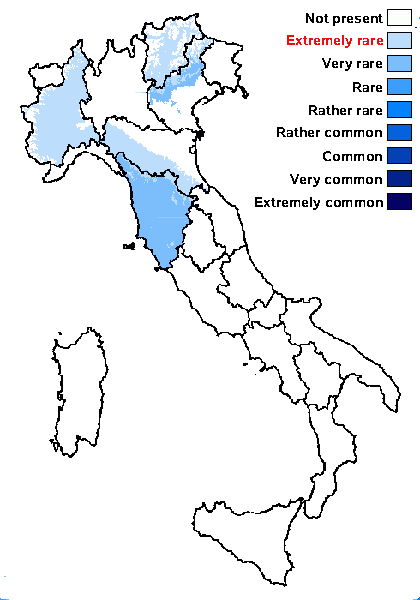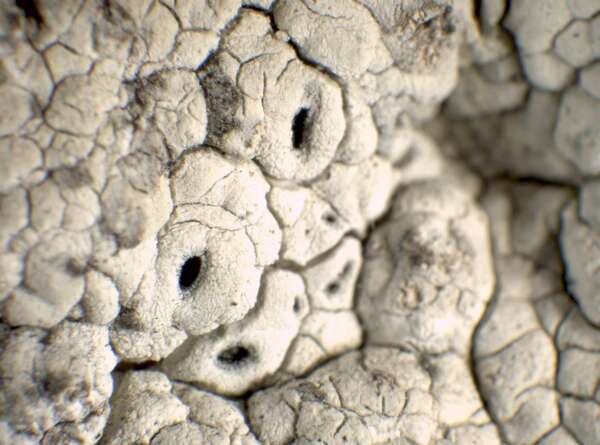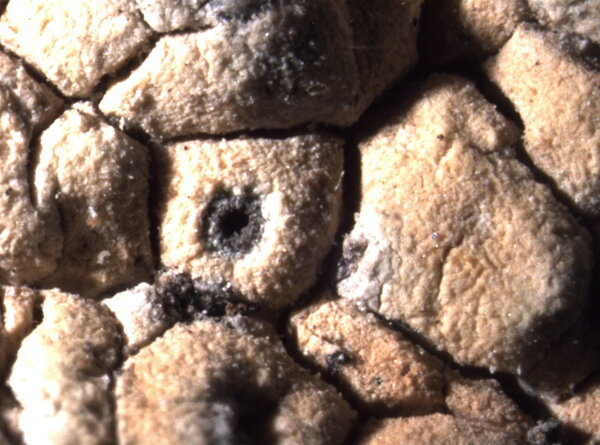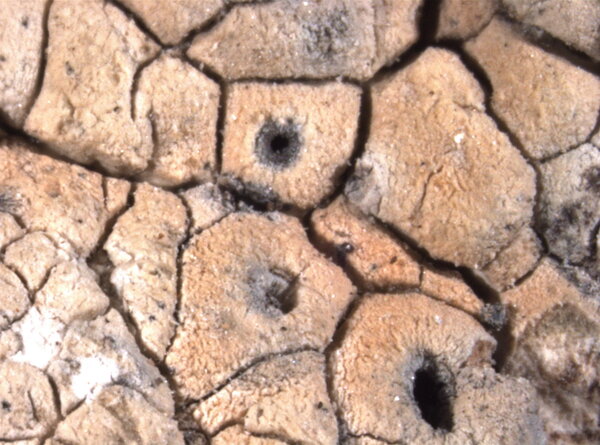Diploschistes candidissimus (Kremp.) Zahlbr.
Cat. Lich. Univ., 2: 660, 1924. Basionym: Limboria candidissima Kremp. in Unger & Kotschy - Die Insel Cypern: 166, 1865.
Synonyms: Acrorixis actinostoma var. tectorum (A. Massal.) Trevis.; Diploschistes actinostoma var. farinosus (Anzi) Zahlbr.; Diploschistes calcareus (Müll. Arg.) J. Steiner; Diploschistes farinosus (Anzi) Vězda; Limboria actinostoma var. tectorum A. Massal.; Urceolaria actinostoma var. farinosa Anzi; Urceolaria actinostoma var. tectorum (A. Massal.) Jatta
Distribution: N - Ven (Lazzarin 2000b), TAA, Piem (TSB 33971), Emil (Fariselli & al. 2020). C - Tosc.
Description: Thallus crustose, episubstratic, well-delimited and forming large patches, rimose-areolate, consisting of 0.5-4 mm wide and 0.3-1.8 mm thick, irregularly angular, flat to slightly convex, chalky white, heavily pruinose areoles. Apothecia common, perithecioid, immersed in the areoles, up to 1.5 mm across (in section), with a blackish, urceolate to finally flat disc not visible from above, being concealed by a thick, radially sulcate proper margin. Proper exciple up to 70 µm thick, carbonized, pseudoparenchymatous; epithecium poorly differentiated, colourless to brownish; hymenium colourless, 120-160 µm high, non-amyloid; paraphyses simple, flexuose, 1.1.5 µm thick, not swollen at apex; hypothecium colourless 10-15 µm high. Asci 4-8-spored, cylindrical to subclavate, the wall eventy thickened, with an abrupt apical thickening and a thin internal apical beak, the contents I+ orange-red, the walls I-, not fissitunicate. Ascospores muriform, with 4-6 transverse and 1-3 longitudinal septa, at first hyaline then brown, broadly ellipsoid, 20-34 x (10-)14-20 µm. Pycnidia black, immersed. Conidia bacilliform. Photobiont chlorococcoid. Spot tests: thallus K-, C+ red, KC-, P-, UV-. Chemistry: lecanoric acid. Note: a mainly Mediterranean species growing on compact calciferous rocks, also found in dry Alpine valleys. The species is both morphologically and molecularly different from D. actinostoma.
Growth form: Crustose
Substrata: rocks
Photobiont: green algae other than Trentepohlia
Reproductive strategy: mainly sexual
Commonnes-rarity: (info)
Alpine belt: absent
Subalpine belt: absent
Oromediterranean belt: absent
Montane belt: extremely rare
Submediterranean belt: extremely rare
Padanian area: absent
Humid submediterranean belt: very rare
Humid mediterranean belt: very rare
Dry mediterranean belt: absent

Predictive model
Herbarium samples
Growth form: Crustose
Substrata: rocks
Photobiont: green algae other than Trentepohlia
Reproductive strategy: mainly sexual
Commonnes-rarity: (info)
Alpine belt: absent
Subalpine belt: absent
Oromediterranean belt: absent
Montane belt: extremely rare
Submediterranean belt: extremely rare
Padanian area: absent
Humid submediterranean belt: very rare
Humid mediterranean belt: very rare
Dry mediterranean belt: absent

Predictive model
| Herbarium samples |
 Index Fungorum
Index Fungorum
 GBIF
GBIF





